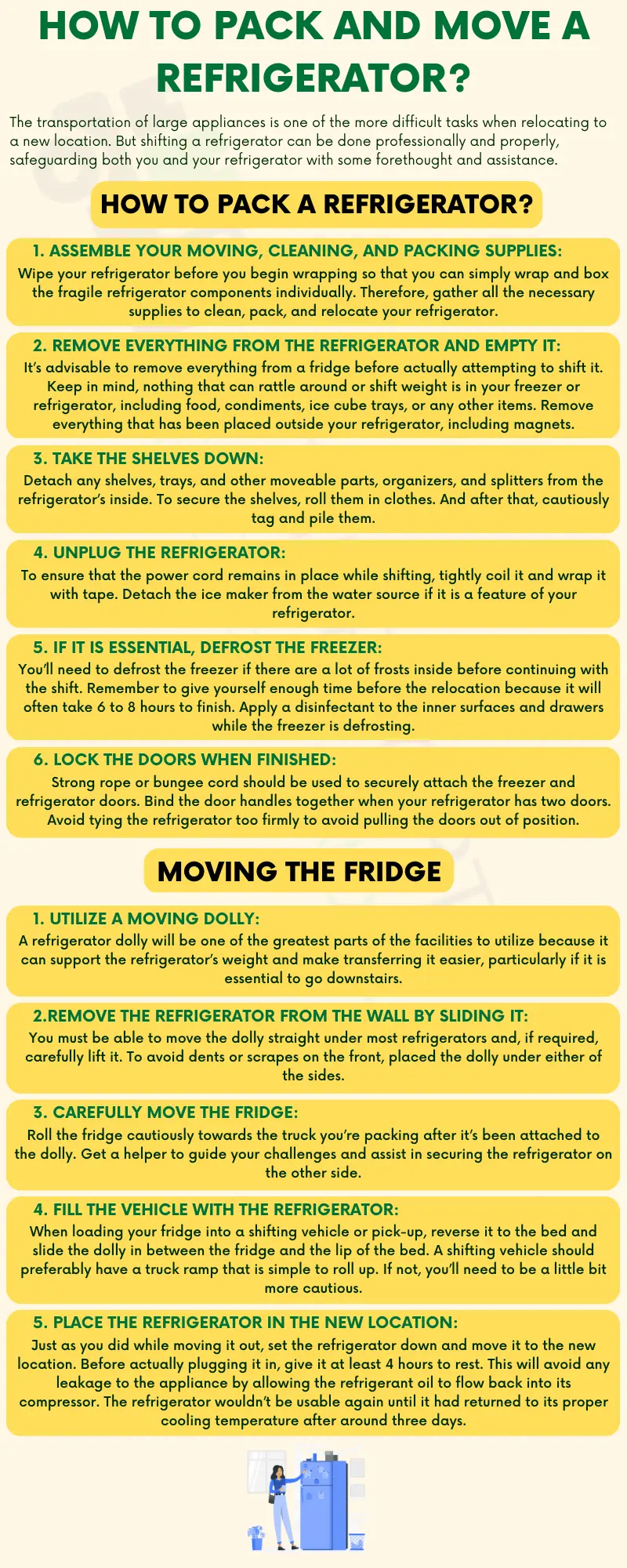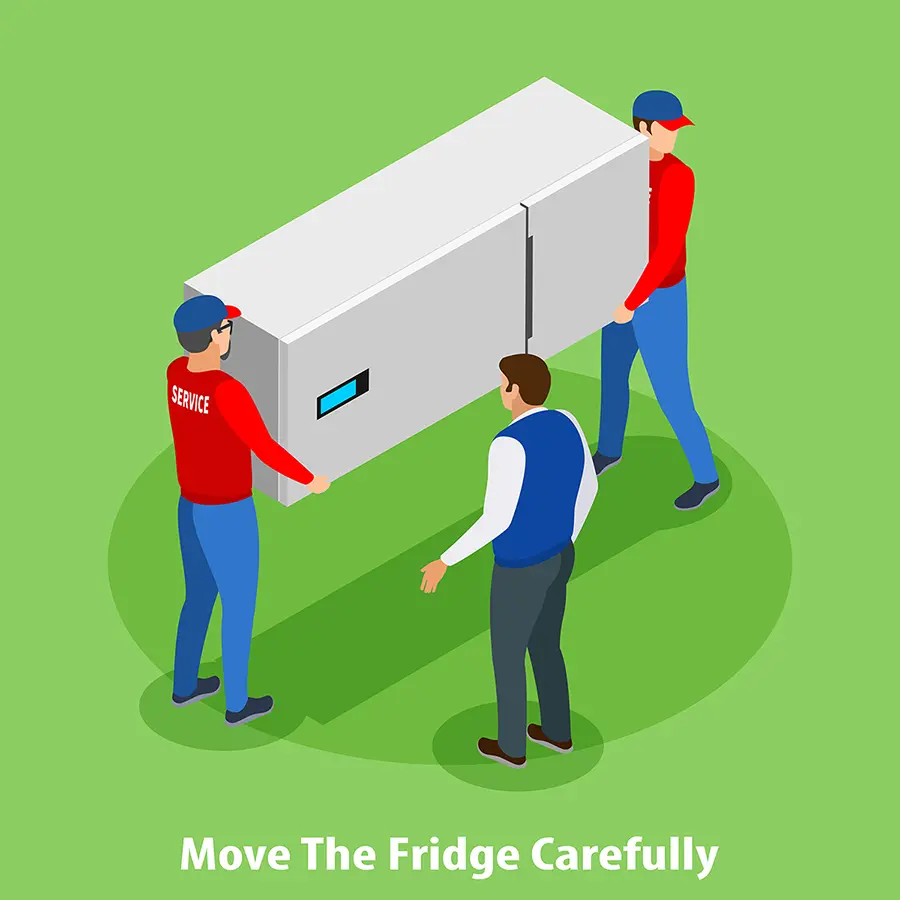The transportation of large appliances is one of the more difficult tasks when relocating to a new location. But shifting a refrigerator can be done professionally and properly, safeguarding both you and your refrigerator with some forethought and assistance.

Pack And Prepare To Relocate The Refrigerator:
1. Assemble Your Moving, Cleaning, And Packing Supplies:
Wipe your refrigerator before you begin wrapping so that you can simply wrap and box the fragile refrigerator components individually. Therefore, gather all the necessary supplies to clean, pack, and relocate your refrigerator.
- Strong cables, rope, or moving belts
- Moving cradle
- Cleaning products
- A toolbox
- Packing materials
- Portable blankets
- Scotch tape
- Scissor\Markers
2. Remove Everything From The Refrigerator And Empty It:
It’s advisable to remove everything from a fridge before actually attempting to shift it. Keep in mind, nothing that can rattle around or shift weight is in your freezer or refrigerator, including food, condiments, ice cube trays, or any other items. Remove everything that has been placed outside your refrigerator, including magnets.

Consume or donate any perishable food items that are in the refrigerator. It’s generally simpler to simply throw away the items you can’t finish right away if you’re in the middle of a major relocation. Remove the things and set them on the counters, even if you only need to relocate the fridge a short distance within the same room. Easily slide it where you want it to go after sliding it out far enough to unplug it.
3. Take The Shelves Down:
Detach any shelves, trays, and other moveable parts, organizers, and splitters from the refrigerator’s inside. To secure the shelves, roll them in clothes. And after that, cautiously tag and pile them. Although you have the option of tape shelving in place rather than removing it, it is advised that you take them out completely and wrap them individually. However, depending on your refrigerator, this might be a good choice.
4. Unplug The Refrigerator:
To ensure that the power cord remains in place while shifting, tightly coil it and wrap it with tape. Detach the ice maker from the water source if it is a feature of your refrigerator.
5. If It Is Essential, Defrost The Freezer:
You’ll need to defrost the freezer if there are a lot of frosts inside before continuing with the shift. Remember to give yourself enough time before the relocation because it will often take 6 to 8 hours to finish. Carry the benefit of the chance to give your refrigerator a pretty complete cleaning before you take it to your new house, rather than wasting a lot of valuable moving time washing it. Apply a disinfectant to the inner surfaces and drawers while the freezer is defrosting.
6. Lock The Doors When Finished:
Strong rope or bungee cord should be used to securely attach the freezer and refrigerator doors. Bind the door handles together when your refrigerator has two doors. Avoid tying the refrigerator too firmly to avoid pulling the doors out of position. It is not advisable to utilize tape to secure the door since it could leave a stain or harm the refrigerator’s surface.
It is advisable to leave the refrigerator doors slightly ajar if the relocation is expected to take more than a day to promote airflow and avoid the growth of mildew.
Moving The Fridge:
1. Utilize A Moving Dolly:
A refrigerator dolly will be one of the greatest parts of the facilities to utilize because it can support the refrigerator’s weight and make transferring it easier, particularly if it is essential to go downstairs. Any strapped dolly will suffice, but keep in mind that the base is large enough to support the bottom of the refrigerator firmly and that the straps are wide enough to securely hold it.
The base’s size is crucial since you must maintain the fridge’s upright position to prevent coolant leaks. You must acquire a moving dolly if you don’t already have one. Although there are moving straps that might be used to secure a refrigerator to your back, purchasing moving straps would be more costly and riskier than leasing a dolly. You shouldn’t try to lift one without it.
2. Remove The Refrigerator From The Wall By Sliding It, Then Fasten It To The Dolly:
You must be able to move the dolly straight under most refrigerators and, if required, carefully lift it. To avoid dents or scrapes on the front, placed the dolly under either of the sides. To assist lessen the possibility of harming finished surfaces, it is highly recommended to insert a towel or cloth between the dolly upright rails and the side of the refrigerator. Utilize moving straps or bungee cords to secure the refrigerator to the dolly. When carrying and placing the refrigerator on the dolly, watch out for any twisting. To prevent refrigerant oil from leaking into the heat exchanger tubes, keep it upright.
Never tilt the refrigerator back or on its side. The heat exchanger tubes could be contacted by refrigerant oil from the compressor. The refrigerant oil may not empty from the heat exchanger tubes when the refrigerator is put back upright, which could result in improper cooling. If laying the refrigerator on its side is necessary due to circumstances beyond your control, try to do so as uprightly as you can. To assist hold the fridge relatively upright, position a box or a large piece of equipment under the top.
3. Carefully Move The Fridge:
Roll the fridge cautiously towards the truck you’re packing after it’s been attached to the dolly. Get a helper to guide your challenges and assist in securing the refrigerator on the other side.

The refrigerator should be lowered onto each new step of a flight of stairs one at a time with the assistance of your assistant. The best arrangement would be to have two people gripping the handles in front of the dolly and another at the back while it is lowered gradually. Do not get too fast and talk loudly.
4. Fill The Vehicle With The Refrigerator:
When loading your fridge into a shifting vehicle or pick-up, reverse it to the bed and slide the dolly in between the fridge and the lip of the bed. A shifting vehicle should preferably have a truck ramp that is simple to roll up. If not, you’ll need to be a little bit more cautious.

You need to climb up into the truck bed and have at least two people on the ground to lift a refrigerator straight up into the bed. Pulling straight up with the dolly arms as the assistants on the ground raise from the base and press it back into the bed requires coordination and synchronized lifting. To prevent falling back upon you from the fridge, it would be preferable to have another assistance with you as well. In the truck, keep the fridge upright. The fridge will be more secure and stable if you could leave it, it would be attached to the dolly, but if you can’t, support it with other pieces of furniture or moving equipment or strap it into position.
5. Place The Refrigerator In The New Location:
Just as you did while moving it out, set the refrigerator down and move it to the new location. Before actually plugging it in, give it at least 4 hours to rest. This will avoid any leakage to the appliance by allowing the refrigerant oil to flow back into its compressor. The refrigerator wouldn’t be usable again until it had returned to its proper cooling temperature after around three days.
Even if you strictly adhere to the instructions, moving a refrigerator on your own might be challenging. Consider employing packers and movers from the 1Support digital portal if you’re seeking a pal with a vehicle to handle everything for you!
With the help of the online portal 1Support, you may connect with a local network of movers who will load, transport, and unload your belongings as needed.
Book with the 1Support right now to avoid the headache of moving a refrigerator yourself!
Frequently Asked Questions
The night before relocating, shut off and unhook your refrigerator. A refrigerator’s evaporator must have adequate time to defrost before being transported, otherwise, you run the risk of causing damage to it. You can also allow the oils and liquids time to settle and cease flowing through the compressor by turning off your refrigerator the night before.
Your refrigerator needs some time to settle after being safely placed in the appropriate location. To give the appliance’s compressor oil time to settle, you should disconnect it and let it stand upright for at least 4 hours. After 4 hours of rest, you may plug in your refrigerator. So you should plug your fridge in 4 hours after the move.


